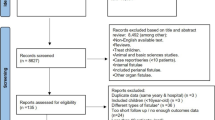Abstract
The objective of this study is to establish the role of risk factors in the etiology of pharyngocutaneous fistula formation after total laryngectomy. A retrospective study was performed for patient, disease and treatment-related factors, and also factors related to pathology specimen. Logistic regression analysis revealed that fistula development ratio was 4.955 times higher in patients with fistula than in the control group when the preoperative hemoglobin value was below 12.2 g/dL, 3.653 times higher when the postoperative hemoglobin value was below 12.2 g/dL, 3.471 times higher in the presence of an accompanying systemic disease, 3.23 times higher when the postoperative albumin level was below 3.5 g/dL, 3.1 times higher when ipsilateral lymph node was positive, 2.05 times higher when erythrocyte suspension is used as transfusion material, and 1.048 times higher when contralateral lymph node was positive. Proper concomitant systemic disease control, maintenance of hematologic values in the pre- and postoperative periods, provision of adequate nutrition, preference of erythrocyte suspensions for transfusion are the key points for the prevention of pharyngocutaneous fistula development. Preoperative detection of positive cervical lymph nodes should alert the physician about the potential development of fistula.
Similar content being viewed by others
References
Paydarfar JA, Birkmeyer NJ (2006) Complications in head and neck surgery: a meta-analysis of postlaryngectomy pharyngocutaneous fistula. Arch Otolaryngol Head Neck Surg 132(1):67–72
Soylu L, Kiroglu M, Aydogan B et al (1998) Pharyngocutaneous fistula following laryngectomy. Head Neck 20(1):22–25
Ikiz AO, Uca M, Güneri EA, Erdağ TK, Sütay S (2000) Pharyngocutaneous fistula and total laryngectomy: possible predisposing factors, with emphasis on pharyngeal myotomy. J Laryngol Otol 114(10):768–771
Tosun F, Gerek M, Birkent H, Ozkaptan Y (2002) Total larenjektomi sonrası farengokütanöz fistül; değişik risk faktörlerinin analizi. T Klin KBB 2:133–139
Sahin E, Taş E, Vural S, Eren Y, Demir C, Ayan N, Gursel AO (2005) Total larenjektomi sonrası farengokütanöz fistül oluşumundaki predispozan faktörler. Bakırköy Tıp Dergisi 1:105–110
Akduman D, Naiboğlu B, Uslu C et al (2008) Total larenjektomi sonrası farengokütanöz fistül: Sıklığı, etkileyen faktörler ve tedavi yaklaşımı. Kulak Burun Bogaz Ihtis Derg 18(6):349–354
Parikh SR, Irish JC, Curran AJ, Gullane PJ, Brown DH, Rotstein LE (1998) Pharyngocutaneous fistulae in laryngectomy patients: the Toronto Hospital experience. J Otolaryngol 27(3):139–140
Fradis M, Podoshin L, Ben David J (1995) Post-laryngectomy pharyngocutaneous fistula—a still unresolved problem. J Laryngol Otol 109(3):221–224
Cavalot AL, Gervasio CF, Nazionale G et al (2000) Pharyngocutaneous fistula as a complication of total laryngectomy: review of the literature and analysis of case records. Otolaryngol Head Neck Surg 123(5):587–592
Redaelli de Zinis LO, Ferrari L, Tomenzoli D, Premoli G, Parrinello G (1999) Postlaryngectomy pharyngocutaneous fistula: incidence, predisposing factors and treatment. Head Neck 21(2):131–138
Onder T, Aktas D, Ozunlu A, Dundar A (1994) Total larenjektomi sonrası erken dönemde oral beslenme. KBB Bülteni 4:106–109
Natvig K, Boysen M, Tausjo J (1993) Fistulae following laryngectomy in patients treated with irradiation. J Laryngol Otol 107(12):1136–1139
Hier M, Black MJ, Lafond G (1993) Pharyngo-cutaneous fistulas after total laryngectomy: incidence, etiology and outcome analysis. J Otolaryngol 22(3):164–166
Virtaniemi JA, Kumpulainen EJ, Hirvikoski PP, Johansson RT, Kosma VM (2001) The incidence and etiology of postlaryngectomy pharyngocutaneous fistulae. Head Neck 23(1):29–33
Tomkinson A, Shore GR, Dingle A, Roblin DG, Qunine S (1996) Pharyngocutaneous fistula following total laryngectomy and post-operative vomiting. Clin Otolaryngol 21(4):369–370
Lundgren J, Olofsson J (1984) Pharyngocutaneous fistula after laryngeal surgery: the role of the barium swallowing. Otolaryngol Head Neck Surg 92(1):19–23
Medina JE, Khafif A (2001) Early oral feeding following total laryngectomy. Laryngoscope 111(3):368–372
Violaris N, Bridger M (1990) Prophylactic antibiotics and post laryngectomy pharyngocutaneous fistulae. J Laryngol Otol 104(3):225–228
Palomar-Asenjo V, Sarroca Capell E, Tobías Gómez S, Pérez Hernández I, Palomar-García V (2008) Pharyngocutaneous fistula following total laryngectomy. A case-control study of risk factors implicated in its onset. Acta Otorrinolaringol Esp 59(10):480–484
Boscolo-Rizzo P, De Cillis G, Marchiori C, Carpenè S, Da Mosto MC (2008) Multivariate analysis of risk factors for pharyngocutaneous fistula after total laryngectomy. Eur Arch Otorhinolaryngol 265(8):929–936
Saki N, Nikakhlagh S, Kazemi M (2008) Pharyngocutaneous fistula after laryngectomy: incidence, predisposing factors, and outcome. Arch Iran Med 11(3):314–317
Mäkitie AA, Niemensivu R, Hero M, Keski-Säntti H, Bäck L, Kajanti M, Lehtonen H, Atula T (2006) Pharyngocutaneous fistula following total laryngectomy: a single institution’s 10-year experience. Eur Arch Otorhinolaryngol 263(12):1127–1130
Qureshi SS, Chaturvedi P, Pai PS, Chaukar DA, Deshpande MS, Pathak KA, D’cruz AK (2005) A prospective study of pharyngocutaneous fistulas following total laryngectomy. J Cancer Res Ther 1(1):51–56
Galli J, De Corso E, Volante M, Almadori G, Paludetti G (2005) Postlaryngectomy pharyngocutaneous fistula: incidence, predisposing factors, and therapy. Otolaryngol Head Neck Surg 133:689–694
Markou KD, Vlachtsis KC, Nikolaou AC, Petridis DG, Kouloulas AI, Daniilidis IC (2004) Incidence and predisposing factors of pharyngocutaneous fistula formation after total laryngectomy. Is there a relationship with tumor recurrence? Eur Arch Otorhinolaryngol 261:61–67
Morton RP, Fielder CP, Dorman EB (1988) Prediction and prevention of fistulae after major head and neck surgery: a preliminary report. Aust N Z J Surg 58(12):951–953
Dedivitis RA, Ribeiro KC, Castro MA, Nascimento PC (2007) Pharyngocutaneous fistula following total laryngectomy. Acta Otorhinolaryngol Ital 27(1):2–5
Wakisaka N, Murono S, Kondo S, Furukawa M, Yoshizaki T (2008) Post-operative pharyngocutaneous fistula after laryngectomy. Auris Nasus Larynx 35(2):203–208
Acknowledgments
The English in this document has been checked by at least two professional editors, both native speakers of English.
Conflict of interest
The authors declare no competing interest. No financial support was received for this paper.
Author information
Authors and Affiliations
Corresponding author
Rights and permissions
About this article
Cite this article
Erdag, M.A., Arslanoglu, S., Onal, K. et al. Pharyngocutaneous fistula following total laryngectomy: multivariate analysis of risk factors. Eur Arch Otorhinolaryngol 270, 173–179 (2013). https://doi.org/10.1007/s00405-012-2111-7
Received:
Accepted:
Published:
Issue Date:
DOI: https://doi.org/10.1007/s00405-012-2111-7




